Flyzone Seawind EP Select Scale RX-R
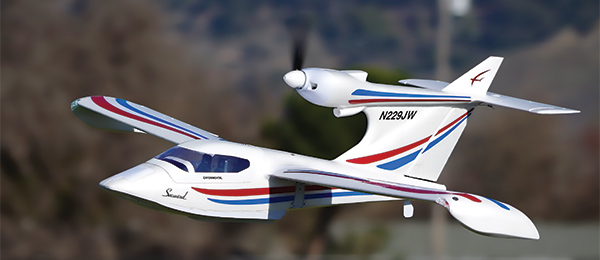
Written by Jon Barnes Fly from land or water with the flick of a switch Product review Photos by the author As seen in the June 2016 issue of Model Aviation.
Specifications
• Model type: Amphibious • Skill level: Intermediate • Wingspan: 56.6 inches • Wing area: 421 square inches • Length: 44.3 inches • Weight: 61 ounces • Power system: 41-19-900 Kv brushless motor; 40-amp ESC (included) • Radio: Minimum six-channel transmitter and receiver • Construction: AeroCell foam • Street price: $229.99Test-model details
• Motor used: 41-19-900 Kv brushless outrunner (installed) • Speed controller: 40-amp brushless with BEC (installed) • Battery: 3S 2,200 mAh 25C LiPo • Propeller: 11.5 x 6 plastic • Radio system: Tactic TTX850 SLT 2.4 GHz transmitter; Tactic TR624 SLT 2.4 GHz receiver • Ready-to-fly weight: 61 ounces • Flight duration: 5 to 8 minutesPluses
• Can be flown from water or land without needing airframe reconfiguration. • Operating speed of the mechanical tricycle gear retracts is kept slow with an electronic speed-reduction module. • A hinged cantilever hatch creates easy access to battery compartment and cockpit. • Bright navigation and landing lights help in reduced-visibility situations. • Toolless wing and horizontal stabilizer attachment systems. • Retractable water rudder enhances control when taxiing on water.Minus
• The horizontal stabilizer did not sit squarely when mounted to the airframe and needed to be shimmed.Product review
On average, an adult human’s body is 60% water. Roughly 71% of the earth’s surface is covered by water. A human cannot survive without water for much more than a week. Armed with those statistics, it should come as no surprise that many pilots are unavoidably attracted to flying their models from water. Some of us typically endeavor to keep a float-equipped airplane or amphibious aircraft on our hangar’s active roster at all times. My all-time fondest flying memory involves a late-evening session with my float-equipped Flyzone Beaver. That evening, the Beaver’s navigation and landing lights twinkled in the dusk. The red and orange western sky was mirrored on the glassy surface of the water. I kept flying, telling myself that I would shoot “just one more touch-and-go.” When I had finally exhausted all of my battery packs and called it a day, the sun had long since set and I was flying the Beaver in the dark. And loving it! Now enter the Flyzone Seawind. Flyzone’s AeroCell foam-composition amphibious model is a flying boat (the fuselage serves as the principal float). This 56-inch wingspan model is based on the real-world amphibious airplane known as the Seawind 300C. One of the most exciting features of the Flyzone Seawind is that it is capable of flying from both land and water in the same flight. The permanently installed set of suspension-equipped, retractable tricycle landing gear even includes a speed-reduction module. This in-line unit slows the deployment and retraction of the tricycle gear, making it operate at a scalelike speed that more accurately mimics the gear used on a full-scale Seawind. With this model, a pilot can switch between land-based and water-based operations at will and in midflight. This feature also negates the need to reconfigure the aircraft based on whether a pilot is heading to a club field or to a local pond. Although Flyzone had my attention with the included retractable landing gear, the model’s list of built-in features is lengthy and impressive. A retractable water rudder automatically deploys when the tricycle landing gear is retracted. Flyzone included a hinged plastic hatch lid to allow pilots easy access to the flight battery, which is a commonly used 3S 2,200 mAh LiPo battery pack. Two sets of gray foam seats are magnetically retained and can easily be removed, if necessary. The seats, as well as twin control yokes and instrumentation graphics, are all visible through the clear cockpit windows and create nice scale realism. The two wing halves mount to the fuselage using a unique, toolless twist-and-lock system and come with both fixed and flashing navigational lights preinstalled in the downturned wingtips. An extra foam spinner and a squeeze bottle that can be used to vacuum water that might get into the airframe are included in the box. And don’t forget the preinstalled brushless power system and full series of seven servos. As a receiver-ready (Rx-R) model, all that a pilot needs to add is a minimum six-channel radio system and a 3S 11.1-volt 25-30C 2,200 mAh LiPo flight battery.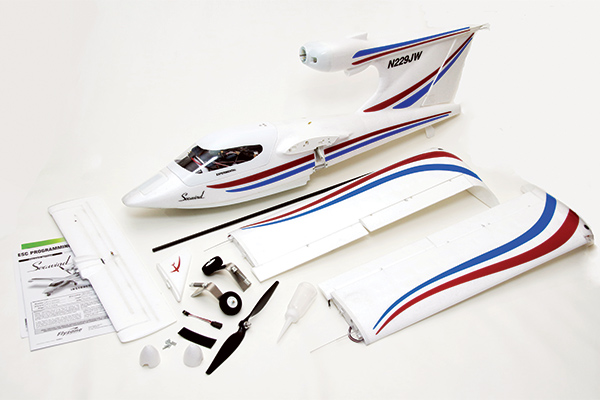
The kit includes an extra foam spinner and a plastic squeegee bottle. The latter is useful for vacuuming out the small amount of water that can make its way into the nose gear well during water-based operations.
Assembly
When starting a fresh build, the first thing I normally do is gather my favorite hand tools. These include a pair of Phillips screwdrivers, one flathead screwdriver, an X-Acto knife with a fresh blade, a pair of curved-jaw hemostats, and a small adjustable wrench. A quick read of the Seawind’s 12-page black and white photo-illustrated assembly manual (Flyzone also includes a two-page speed controller programming guide) revealed that the bulk of the airframe assembly can be completed without tools! Flyzone engineered an innovative approach to securing the wing halves to the fuselage. Simply slide each half onto the carbon-fiber spar, guide it into the plastic wing saddle, and rotate the trailing edge upward. A plastic retainer is then used to lock the wing into position. The horizontal stabilizer/elevator assembly similarly keys into the airframe without the need for traditional hand tools. I noticed that this stabilizer did not sit as squarely as it needed to when mounted to the airframe. I was able to align it by shimming the low side with a thin sliver of balsa. With the main airframe components assembled, the builder will have to wield a screwdriver or two to mount the two retractable main gear assemblies and to secure the various pushrods into their quick-link connectors. Access to the somewhat cavernous fuselage interior is gained by lifting the large canopy hatch. Detents on the two cantilever arms lock the canopy into the raised position, which makes it easier to work “under the hood.” The first time that I lifted the hatch on the Seawind, I was surprised to find that the rear-mounted hinge was not engaged in the fuselage-mounted receiver. I figured that popping it back into place would be a quick and easy endeavor, but it wasn’t. As my double dose of patience pills was starting to wear off, I finally succeeded in getting it back into position.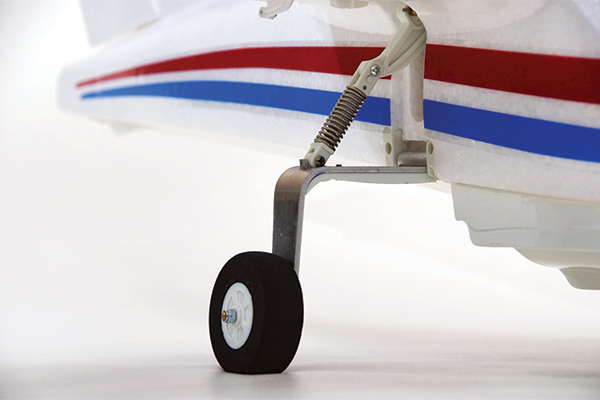
The spring-loaded, aluminum-composition main landing gear proved to be sturdy and dependable.
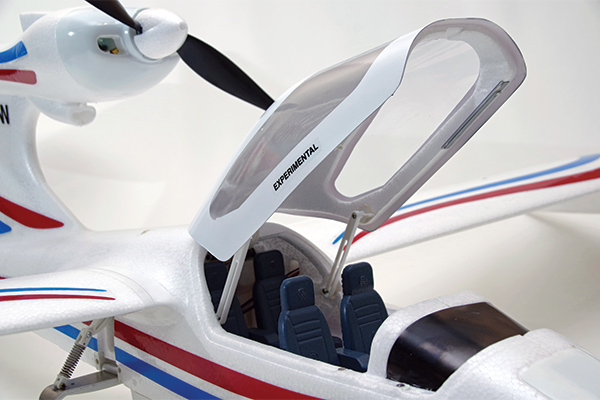
The cantilever canopy latches in the open position, making flight battery swaps easier.
After the two wing halves have been secured in place, the twin small-diameter flap pushrods must be inserted into the same quick-link connector. The flap servo is positioned aft of the canopy opening, on the roof of the cockpit. Although younger builders will probably breeze through this step, my 50-something eyesight found this task challenging. The two wing halves are easily removable, thanks to the toolless retainers used to secure them, but I decided that I would refrain from routinely removing them to avoid having to thread the needles again. Fortunately, the Seawind is compact when fully assembled and does not present any storage or transportation challenges.
Flying
Although most of the earth’s water is saltwater, I recommend flying the Seawind off of freshwater. The salinity of seawater can be caustic to unprotected metal parts. Although there are products available that can be used to apply a protective, water-resistant coating to electronics, for the sake of this review and to fully explore the design of this amphibious model, I decided that it was best to forego the application of any such products. While perched atop my soapbox, I would also like to remind pilots of the risks inherent to flying amphibious models off of bodies of water with currents. Nothing could be more disheartening than helplessly watching one’s upended or battery-depleted amphibious model carried downstream and out of sight. Pilots who suddenly find themselves in such a scenario have been known to make unwise and potentially unsafe decisions. It is important to respect the water, especially in colder weather. With that quick word from the safety officer and a site-specific radio range check aside, I was ready to fly the Seawind. Because this model is primarily designed to fly from water, it seemed fitting to head for my favorite local pond first. Modelers with access to a lake that includes a boat-launching ramp will love the way that the Seawind can be taxied across the pavement, directly down the ramp, and into the water. And the reverse of that procedure after landing is even cooler! The water rudder that automatically deploys from the aft end of the fuselage exerts a respectable amount of control authority during low-speed taxiing on water. The included Fowler-style flaps offer pilots options when it comes to takeoffs and landings. Although I tried plenty of them in a variety of configurations, I found that I preferred executing departures and arrivals with the flaps fully deployed. This configuration helps the Seawind break free from water and land in a shorter distance than when they are not used.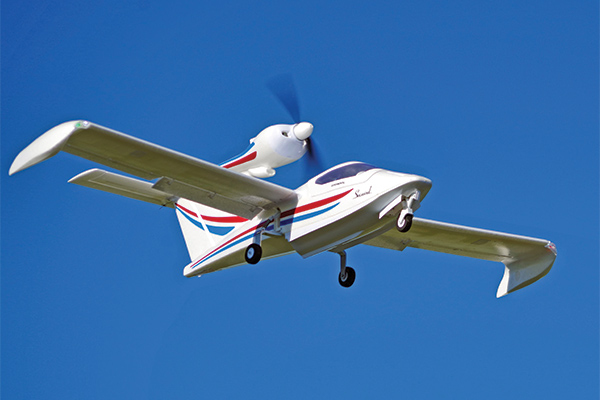
The included flaps enhance the Seawind’s slow-speed capabilities.
Carrying too much speed when attempting to land on water with the flaps deployed often resulted in a multibounce touchdown. Holding the Seawind off for as long as possible, allowing it to scrub most of its forward speed while slightly above the water’s surface, resulted in the best water landings. Executing picture-perfect landings on the terra firma seemed an easier task, probably in part because of the suspension-equipped retractable landing gear. The Seawind’s stall speed is slow, and when the model finally decides that it is done flying, the stall is semisoft and easily recoverable. Another feature that I found useful was the bright strobing navigation and solid-white landing lights that come preinstalled in the Seawind’s wingtips. It is not uncommon for California winter weather to include periods of incredibly dense, ground-level fog. During one of the land-based Seawind’s outings, an intense band of fog suddenly enveloped the field. Although the predominantly white Seawind airframe demonstrated an amazing Houdinilike ability to almost disappear momentarily into the fog, the bright marker lights offered enough orientation cues to allow me to keep flying! Because fog usually coats everything it touches with a damp blanket of dew, I decided to experiment with landings and departures from the wet grass. Although the grass at the field hadn’t been mowed for a while, I was excited to find that the Seawind was able to land and take off from the grassy green sea with no problem!
Conclusion
Although the Flyzone Beaver has been the king of my amphibious fleet for some time now, the grab-and-go convenience of the Seawind’s retractable tricycle-gear-equipped seaplane airframe has me giving it the noble nod. With the need to swap back and forth from floats to wheels negated, this model is ready to go flying wherever and whenever! I enjoy the extra level of detail inherent to Flyzone’s Select Scale series of models. Whether in the air, on the water, or in a hangar, the included cockpit details, flaps, and lighting system endow the Seawind with a pleasing level of sport-scale realism.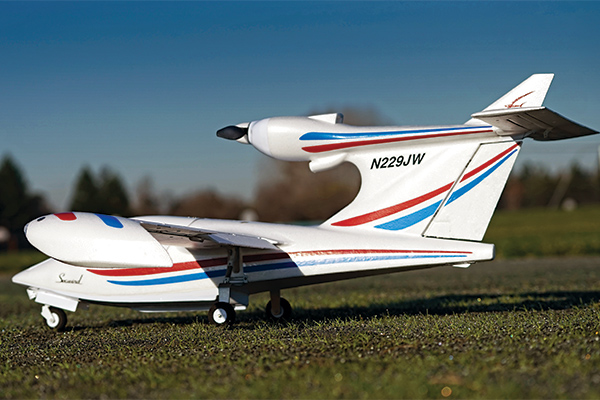
The Seawind comes out of the box 100% ready for both land- and water-based operations.
Flight duration on 3S 2,200 mAh LiPo batteries, of which many pilots have an ample inventory, can be long and satisfying. The sole caveat, when engaging in water-based flight operations, is that the model requires a more-frequent, thorough maintenance regimen than its land-based counterpart. Continual exposure to water can cause metal components to rust. I found it best to spend a little time making sure that I completely dried the Seawind airframe. I even used the included plastic squeeze bottle to vacuum the water out of the nose gear compartment before returning it to the hangar. A light coating of machine oil will keep the pushrods from rusting. The broad, in-flight performance profile and all-weather, all-surface capabilities of the Flyzone Seawind have me committed to keeping this exciting model serviced and standing by for many more flight outings to come! —Jon Barnes [email protected]










4 comments
Seawind
Seawind
Flyzone Seawind
flyzone planes you are not going to repair much at all.I have
Add new comment